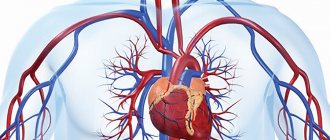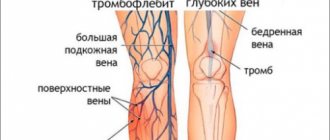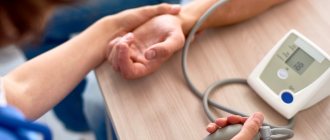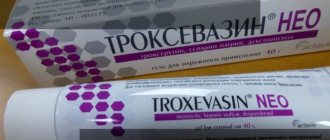Causes of pain in the veins in the arms
Only a phlebologist (a doctor who specializes in the treatment of vein diseases) can reliably say why the veins in the arms hurt. If such a specialist is not available in the medical institution, you should contact a traumatologist or surgeon. After the patient has undergone the necessary tests and undergone a thorough examination, an accurate diagnosis can be made. Venous pain can occur for a number of reasons. Among them there are also serious pathologies. Here are some of them:
- presence of cardiovascular diseases;
- obstruction of blood flow to the upper extremities;
- presence of previous injuries;
- genetic predisposition;
- being overweight and having bad habits, in particular smoking.
These are just some of the reasons why the veins in the arms hurt. An important role in the occurrence of this phenomenon is played by the human factor, which manifests itself when giving an intravenous injection or after taking blood for tests.
Medical myths. All about blood donation
June 14 is World Blood Donor Day. To mark the occasion, Medical News Today is publishing another edition of Medical Myths, which examines some of the prejudices and misconceptions associated with blood donation.
In the United States alone, more than 13.2 million people are donors. In general, on the globe, according to PubMed Central (a scientometric database of the US National Institutes of Health. - Note by Lakhta Clinic ), people annually donate over 100 million units of donor blood.
Blood storage time is limited and the key is to donate on a regular basis. As the World Health Organization explains, “Your decision to donate a little blood could save someone's life, or even several lives, if the blood is separated into individual components—red blood cells, platelets, and plasma—that are critically needed for certain diseases.”
Medical News Today contacted Dr. James F. Kenney, vice chair of emergency medicine at Staten Island University Hospital in New York City. He outlined the social significance of blood donation succinctly and clearly:
“Patients who have undergone severe trauma or abdominal surgery, are receiving chemotherapy, or have bone marrow diseases all typically require transfusions of blood or blood components simply to survive. Blood products are transfused in the United States every two seconds—that's 21 million transfusions a year.”
If you donate blood, you might get sick
None of the donors who were healthy before donating blood will become less healthy after the procedure. Although doctors recommend that donors rest for a day, avoid exercise and drink plenty of fluids, their health is not in danger.
Within about 48 hours after donating blood, its volume in the body is completely restored, mainly due to an increase in plasma volume. In 4-8 weeks, the body will also replace the loss of red blood cells.
We spoke with Emanuel T. Ferro, Ph.D., a clinical laboratory physician at MemorialCare Orange Coast Medical Center (Fontaine Valley, Calif.), who is also director of the Blood Bank, Donor Center, and Transfusion Medicine Department at MemorialCare Long Beach Medical Center (Long Beach). , California). Here are his words:
“Blood donation is absolutely harmless. The vast majority of donors who contact our center can donate up to half a liter of blood within 15 minutes, after filling out a health questionnaire and a rapid medical examination with a blood test to ensure that it is safe for transfusion. Any reactions from the donor’s body are rare.”
At the same time, no one hides the fact that minor side effects are sometimes actually observed. As Dr. John Raymo, medical director of Long Island Jewish Forest Hills (Queens, New York), explained to us:
“You may feel some fatigue or dizziness afterward. These symptoms will go away on their own, but you may be able to feel better faster by drinking some water or eating a snack. A bruise and slight pain in the elbow bend are also possible, but I don’t even know if it’s worth talking about such trifles.”
Dr Kenny added that "people who are younger and/or have a low body mass index" are more likely to experience dizziness, but this is "easily preventable by ensuring the body is well hydrated before donating blood."
Elderly people cannot donate blood
They can. In the United States, people over 16 years of age and weighing more than 50 kilograms can donate blood. It should be noted, however, that the rules, restrictions and contraindications vary from country to country. For example, in the United Kingdom, people between the ages of 17 and 66 can donate blood; but those who have donated blood before can continue to do so until they reach the age of 70, and even after seventy people have the right to donate blood if they have donated it within the last two years. There are also certain nuances depending on what specific needs the blood is taken for - in general, all this can be easily clarified by phone or on the website of the relevant service.
A person who constantly takes medications cannot be a donor
This is partly a myth too. Of course, you should inform that you are taking any medications, especially anticoagulants, antiplatelet agents, and some dermatological agents, the use of which is indeed a contraindication to blood donation.
However, in most cases, taking medications does not preclude donation. It is important to note that if you are prescribed a specific drug therapy regimen, you should not interrupt it on the day of blood donation.
Donation takes a lot of time
Some time is spent on registration, conversation and inspection. The procedure itself lasts 8-10 minutes. The American Red Cross clarifies that in total “the process takes approximately 1 hour and 15 minutes.”
Considering the obvious vital importance of donation - is it really that much?
By donating blood, you can become infected with something
Sporadic cases of infection from donated blood should not be confused with infection of the donors themselves during blood collection.
Dr. E.T. Ferro explained to us why such a risk is excluded: “Of course, we use a technique to sterilize the area on the arm where the needle is placed. Almost no one has heard of infection in such conditions. Absolutely all needles used are new, sterile and disposable, meaning there is no chance of contracting a blood-borne infection at the time of donation.”
And if I get a blood transfusion, can I get infected?
Although this myth is not directly related to donation itself, it was popular (mainly due to irresponsible “sensations” in the media) about thirty years ago, and still exists: as if transfusion procedures are associated with a high risk of infection.
Word from James F. Kenny:
“It is clear that people can become infected through transfusion only if the donor blood is infected. However, this is extremely rare nowadays, since all blood is carefully tested for the presence of many dangerous and most common viruses and bacteria. For example, the risk of contracting hepatitis C through a blood transfusion today is about one in one hundred million.”
Donating blood is painful
Well, let's talk about that too. Yes, skin receptors sense the moment the needle is inserted, but this, firstly, is a very short-term effect, and secondly, there is nothing special to endure. From the moment the needle is in the desired position, the donor should feel quite comfortable.
Yes, after donation you may feel something at the injection site for a day or two. In some cases, a noticeable bruise remains, but PubMed Central does not contain data on the harmfulness of this phenomenon, which resolves without a trace within a few days.
You can donate blood no more than once a year
Not true. As shown above, the resource of blood cells (see “Clinical blood test” [link!]) is completely restored no later than 8 weeks, after which you can donate blood again. Given these data, the American Red Cross recommends that repeat whole blood donors take a 56-day break.
People with tattoos or piercings cannot be donors
This belief is one of the most enduring and widespread, but it is still a myth. From the American Red Cross: "Wait three months after tattooing if tattooed in a state where tattoo parlors are not regulated."
The same source explains that donating blood after a piercing “is acceptable if disposable disposable instruments were used. Otherwise, if the piercing was performed using reusable equipment, it is advisable to wait 3 months before donating blood.”
Blood should not be donated to people with high blood pressure
This is not always true.
If systolic pressure is below 180 mm Hg. Art., and diastolic below 100 mm Hg. Art., you can donate blood. Taking antihypertensive medications is also not a contraindication to donation.
You should not donate blood if you have high cholesterol.
This is already a pure myth. Neither high blood cholesterol levels nor taking medications to reduce this indicator are a contraindication to donation.
Vegetarians and vegans are not allowed to donate blood
Another fairy tale. As Dr. E.T. Ferro clearly explained to us, “any person who meets the established requirements and has no contraindications, which veganism itself does not include, can donate blood. Some vegetarians/vegans may not consume enough iron in their diet, resulting in borderline anemia. However, each potential donor undergoes a preliminary analysis and is checked in this regard, i.e. if a tendency towards anemia is detected, he will not donate blood.”
There are enough donors without me
Unfortunately, it is not.
Blood has a limited shelf life, and maintaining adequate supplies is a constant challenge. According to Dr. John Raymo, “donor red blood cells should be used within forty-two days, and donor platelets should be stored for no more than five days. Therefore, blood supplies must be constantly replenished, and we always need volunteer donors.”
And again about the importance of donation. Dr. Emanuel Ferro: “There is always a need for donors, and there are always shortages. […] The number of regular donors is much lower than most people outside of medicine realize. "Each donor is thoroughly screened for infectious diseases and other conditions that could make the blood unsuitable for other people." But at the same time, says Dr. James Kenney, no more than a third of the US population could potentially be blood donors, and only three percent of these potential donors actually donate blood on a regular basis. Additionally, in many cases patients require a specific type of blood; Special banks may have sufficient stocks of one type and be critically short of another.”
Therefore, donor blood is always needed. Very necessary.
Based on materials from Medical News Today
Comment from Lakhta Clinic . And there is no arguing, and everyone understands this: blood donors in the most direct and unambiguous way save the lives of other people. Did you notice the statistics at the beginning of the article? “In the US, more than 13.2 million people are donors.” If we take the US population to be 329 million (well, approximately), then it comes out to more than 4%.
Now let's turn to the data from our National Medical Research Study.
Guys, what is wrong with us...
The author of these lines donated blood three months ago, but, honestly, the reason was quite specific and targeted: a close friend was facing a serious operation. And the previous time it was several years ago, and also, as it were, forcedly, in a similar situation: “for the maternity hospital.”
Let's please agree without further ado, go and donate blood just like that. OK?
Everything we need to know is posted here and here, and for St. Petersburg - here
Blood collection
If blood sampling was performed with an inexperienced hand, a bruise, bump, or, even worse, pain may occur. My arm hurts after donating blood from a vein in the elbow joint. Sometimes the pain may seem to be concentrated in the elbow. Possible reasons for this are:
- blunt needle or inappropriate size;
- incorrectly selected puncture site;
- the needle broke during the procedure;
- improper treatment of the puncture site;
- the vein was punctured right through.
What causes a hematoma to appear and pain can be clearly felt? This phenomenon is caused by the leakage of blood into the tissue. If the feeling of pain increases, the body temperature rises, and swelling forms at the site where the test was taken or a lump appears that has hardened, you should immediately consult a doctor.
Pain after drawing blood from a vein may occur due to incorrect actions of a medical professional
However, the manifestation of the human factor is possible not only due to the actions of an inexperienced nurse or laboratory assistant. The individual and age characteristics of the patient also have an effect, for example, the fragility of blood vessels, their thickness, the speed of blood clotting and general condition. Someone may immediately leave with a heavy bag in their hands after taking blood, while for others, lifting a bottle of water half an hour after the procedure can cause a bruise.
In order to avoid bruising at the puncture site, two simple rules must be followed, which especially need to be taken into account during pregnancy:
- A swab or alcohol wipe soaked in alcohol is not removed from the injection site until blood in the form of small droplets no longer remains on the swab. After a period of time determined by the body, the blood at the puncture site coagulates, which prevents further blood from flowing through the hole left after the injection.
- Avoid carrying heavy objects in the arm that received the injection throughout the day. Also, blood pressure measurements should not be taken on this arm.
Dangerous disease
Sometimes a bruise after taking blood from a vein is formed due to the individual or age characteristics of the patient, for example:
- the vessels are too fragile;
- the patient is overly active in the process of donating biological material.
If your arm hurts after taking blood from a vein, this should alert the patient. Sometimes such a reaction is observed due to the development of varicose veins or another disease. Much depends on physical fitness. A person who exercises is less likely to encounter the problem of poor functioning of blood vessels and muscles.
Phlebitis
This disease is manifested by inflammation of the venous walls, usually of the lower extremities. However, the blood vessels of the hands can also become inflamed. Symptoms that appear with this disease may be the following:
- swelling of the limb appeared, it became swollen;
- my hands hurt;
- the vein swelled, and the venous system clearly showed its pattern;
- heart rate increases;
- body temperature rises;
- a blue-red color of the limb appears.
The most common cause of vein inflammation is catheterization.
When performing the catheterization procedure, the dependence of the appearance of inflammation on the size of the catheter, the place where it is inserted, the time period of its presence in the vein, as well as the type of drug injected into the body can be traced. The danger also lies in the fact that when such a tube is inserted into the bloodstream, an infection may occur.
Complexes with this research
Entry into IVF Examination when a woman enters the IVF procedure 15,090 ₽ Composition
Expanded hospital complex Expanded infectious screening for prevention and hospitalization 4,390 ₽ Composition
Examination during pregnancy. 1st trimester 10,260 ₽ Composition
IN OTHER COMPLEXES
- Coagulogram RUB 1,190
- Preventative check-up RUB 3,570
- Examination during pregnancy. 3rd trimester 5,820 RUR
- Miscarriage RUB 28,220
- Risk of severe COVID-19 600 RUR
Varicose veins
Varicose veins (a simplified name for varicose veins) is a pathological process that leads to damage to the veins.
With this disease, so-called nodes are formed, which are aneurysal-like (similar to an aneurysm - protrusion of the walls of the arteries due to their thinning) local expansions.
Varicose veins are characterized by an increase in the diameter of the lumen and thinning of the venous wall itself.
Varicose veins most often affect the vessels of the legs, but sometimes manifests itself in other organs. Since the arms are constantly exposed to stress and, in addition, are most often lowered, the blood flow to them is increased. This gradually leads to stagnation. Initially, the appearance of dilated veins occurs on the hands. Due to the appearance of such a symptom, it is recommended to consult a specialist, since bloating of the veins is possible not only with varicose veins, but also with other pathologies.
Sometimes the disease is accompanied by painful sensations. This occurs due to impaired functioning of the vascular valves. Violation of their performance leads to an increase in blood pressure, as a result of which, in turn, the vessels begin to twist. It is this process that can cause severe pain. Therefore, you should not wait for the disease to develop, because at the initial stage it is much easier to treat.
Self-treatment for such diseases is not recommended, as this can lead to bad consequences. And an experienced specialist will choose an effective and correct method of treatment. Sometimes surgery may be required, the details of which will be discussed with your doctor.
It should be noted that there is an opinion that varicose veins of the arms do not exist in nature. However, thinned and bulging veins do occur on the upper extremities.
Prevention of complications after an injection
So as not to appear
and hematomas, you must adhere to the following rules:
- Do not tense the muscles in your buttocks during the procedure. This increases the risk of complications after the injection.
- The nurse must maintain the depth of needle insertion.
- Thin needles are not intended for injections; they can only be used for IVs. When drawing blood, they can damage the walls of the veins.
- Do not administer the drug very sharply.
- The cotton wool should be kept at the injection site for at least 10 minutes.
- You should not sit on a chair immediately after the procedure. Better walk down the corridor for 10 minutes.
- Syringes with a special gasket on the piston allow you to inject the drug slowly, in a thin stream. This significantly reduces the risk of vascular damage.
- The professional level of the nurse is also of great importance. Only an experienced specialist can correctly select the required needle length, taking into account the patient’s build and age.
Thrombosis
Usually the disease manifests itself in damage to the blood vessels in the legs, which experience heavy stress. But cases of diseases manifesting in other organs are also found in medical practice. The likelihood of death with thrombosis of the upper extremities is very small, in contrast to the manifestation of the disease in the lower extremities or other organs. The formation of blood clots in superficial veins rarely causes serious problems.
Deep vein thrombosis is a disease of the veins accompanied by the formation of blood clots that interfere with the flow of blood
Symptoms of pathology:
- bursting pain occurs;
- swelling appears along the vein, nearby tissues swell;
- there is an increase in temperature;
- the vein is dilated or greatly inflated;
- palpation allows you to detect compaction in the affected area;
- the skin of the hand turns red, purple, or appears blue.
The main reason for the development of the disease is stagnation of blood in the vessels. This becomes possible with little physical activity or with prolonged forced immobility. Other causes of thrombosis include:
- excessive physical activity placed on the hands;
- surgical procedures, such as implantation of a stimulator;
- vascular injuries;
- the appearance of a cancerous tumor near the vessel;
- introduction of infection.
If the catheter was kept in the vessel for a long time due to the production of a daily dropper, this could cause irritation of the walls of the vein and subsequently the appearance of a blood clot.
Why does my arm hurt after drawing blood from a vein?
To determine the exact cause of pain in the arm after taking blood from a vein, you need to undergo a number of examinations. Such a symptom may indicate a dysfunction of internal organs or disease and therefore requires attention.
The main causes of pain and bruises after donating biological material include:
- circulatory disorders;
- genetic predisposition;
- obesity;
- smoking;
- non-compliance with material collection techniques;
- using a large diameter needle;
- incorrect choice of site for collecting material by a medical specialist;
- imperfect treatment of the venipuncture site;
- puncture through the walls of the vein.
Only a doctor can indicate the cause of pain. In most cases, it does not cause severe discomfort, and the formation of a hematoma provokes the leakage of venous blood into the tissue. If there is increased pain, deterioration in health, or increased body temperature, you should consult a doctor.
- What to do if a lump forms after taking blood from a vein
Pathological symptoms can be triggered by individual characteristics of the human body, for example, fragile blood vessels, excessive activity of the patient during the procedure, heavy physical activity after taking samples.
However, they can manifest themselves with the development of diseases that require mandatory treatment, for example, this can happen with varicose veins.
Other manifestations of vascular diseases of the hands
Symptoms of diseases associated with the vessels of the upper extremities can appear in the fingers of the left or right hand. In these cases, during physical activity the following occurs:
- pain or cramps;
- fingers get tired quickly;
- the tip of one or more fingers goes numb;
- the skin on the hands and fingers becomes cold and pale;
- fatigue increases;
- heaviness appears in the hands;
- weakness may be felt;
- gradual thickening of the nails occurs;
- hair becomes sparse.
Over time, the lumen inside the vessel becomes smaller and smaller, therefore, the blood flow decreases even more. With any stress, fingers and hands hurt, and their skin becomes constantly cold.
Varicose veins
With varicose veins, the full functioning of the veins is disrupted. As the disease develops, nodes form, which over time begin to bulge and expand. Most often, varicose veins develop on the legs. In some cases, it appears on the hands. If a person needs to constantly carry weights, this can provoke the appearance of disease in the upper extremities. Due to systematic stress on the hand, stagnation appears.
Sometimes pathologies cause pain due to disturbances in the functioning of vascular valves. Due to the dysfunction of blood vessels, blood pressure increases. For this reason, the vessels are deformed and can twist. As a result, severe pain develops. How to prevent pain in the arm after taking blood from a vein is of interest to many. To do this, it is important to donate biological material only to qualified and experienced healthcare workers. It is important not to remove the cotton wool from your hand immediately after the procedure.
Methodology
The analysis is taken from a vein painlessly, using automatic vacuum systems. Blood sampling is carried out by a highly qualified nurse in a sterile treatment room, following the anti-AIDS program (all consumables are disposable). The innovative vacuum systems used for collecting venous blood consist of a test tube with a vacuum and a chemical reagent inside, a thin needle and an adapter (holder). They are durable, have color-coded caps for various types of tests, completely eliminate contact of the biomaterial with the hands of medical staff, and do not require the use of additional instruments. Donating blood using this method is painless and safe.











